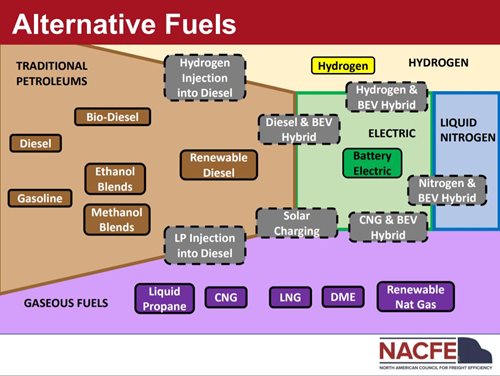
Image Source: https://nacfe.org/emerging-technology/electric-trucks-2/viable-class-7-8/
I just had a chance to meet with my good friend, David Schaller from NACFE, for dinner. For those of you not familiar with the NACFE acronym it stands for the North American Council for Freight Efficiency. NACFE is dedicated to doubling freight efficiency and is relentlessly evaluating emerging technologies to understand how today’s drivers and owners will use it to increase efficiency.
David had told me to give him a call if I was ever in the area where he lives and as luck would have it we were able to meet at a socially appropriate distance for dinner last week. It is always interesting to talk to David as he is a retired engineer with many years of service to the trucking industry.
Our conversation quickly went in the direction of how will the trucks of the future be powered and fueled to move the commerce of not only the United States but the entire world. Dave asked me how many ways was there to power a truck at the current time? Off the cuff, my answer was something like 10 or 15. David chuckled as he pointed out there were over 20 different technologies at play currently.
The reason for bringing this dinner conversation to all of the readers of my blog is simple. We as industry stakeholders need to stay informed as to the direction that the equipment we use to transport goods is taking. If we do not stay involved and on top of this issue we are taking the chance of missing the boat. I am sure there were many successful wagon operators powered by horses who scoffed at many of the new technologies which emerged in the 1800s. I would imagine there was a similar attitude in the marine world with regards to the reliable and proven sail ships of the time.
There are many technologies on the chart that David uses as the opening slide to his NACFE presentation on the subject of what will power our trucks of the future. With David's permission, I am sharing this very chart with you to evaluate. Of course, diesel fuel will be a major player for quite some time but to turn a blind eye to other possible fuel sources could be at our businesses' peril.
Two alternative propulsion systems that garner my attention are diesel-electric and electric drive-trains. Diesel-electric and electric-powered vehicles have been around for a long time. Nearly every railroad locomotive you see going down the tracks uses one of these two different but related motive systems.
I find it interesting that the electric motor predates the internal combustion engine by approximately 20 years. In fact, many of the early automobiles and trucks were powered by electric motors with batteries as the method of storing the needed energy to propel the vehicle. If you are ever at the Iowa 80 travel center make sure to visit the trucking museum which is on-site. Inside the museum, you will find an electric truck accompanied by a well-documented history of the electric vehicle.
Just two years ago I also had the opportunity to learn more about electric vehicles while at a brass era car museum in Maine. The story told was one of the reliability of electric vehicles. So why did the internal combustion engine rule the road for over a century?
From everything I have been able to gather, the big advantage of the fossil-fueled vehicle has been the power density and ease of refueling. It is quite simple, outfit a vehicle with enough fuel tank capacity to cover the number of miles the user wishes to cover between refueling events. Due to the energy density, diesel will be the fuel of choice for quite some time.
My Two Favorites
First, let’s visit the diesel-electric method of power delivery used by the majority of railroad locomotives. The diesel engine is simply the power source to generate electricity to supply the energy to run the electric traction motors which exert the tractive effort needed to move the train. This system allows the diesel engine to operate at its given peak power or efficiency level due to the fact it is not connected through gears directly to the wheels. Think of the diesel-electric as a version of a constant velocity transmission and you will be close. Other additional benefits of a diesel-electric driveline are its easy adaptability to operate as a hybrid when combined with batteries to store energy. This allows for the use of a much smaller diesel engine, as the reserve power to climb a grade will come from the stored energy in the batteries. This technology is also conclusive to use regenerative energy in order to capture energy which would have simply been lost while slowing down or going downhill.
Second is the battery-powered electric truck which combines all of the advantages above along with some other side benefits. First and foremost, quality with an electric truck is the emissions equipment will not be on the truck. On an all-electric truck, the onus of meeting emissions will be shifted to the suppliers of the electric energy source. Acceleration from an electric drive-train is quicker due to one hundred percent of available torque instantly. Additionally, an electric vehicle can take advantage of the energy generated by fossil fuels, nuclear, solar, wind, hydro-electric, tidal, geothermal, and who knows what in the future. The reliability of electric motors along with long life and simplicity seem to be the hallmarks that seemingly will bring this technology of the past into the future, as soon as the range/storage capacity or charge time is brought in line with the refueling time required for a diesel truck.